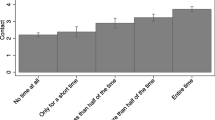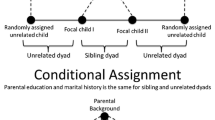Abstract
In this paper we aim to reach beyond the dyadic perspective on intergenerational contact and examine the influence of the sibling network on parent–child contact. We include aggregate sibling network characteristics as well as the adult child’s position in the network vis-à-vis siblings, and use data from the Netherlands Kinship Panel Study (2002–2004 NKPS; N = 4,601 dyads). Regarding aggregate network characteristics results show that having sisters, having stepsiblings, increasing geographical distance between siblings, and decreasing levels of network cohesion are associated with less contact per parent–child dyad. Regarding the position of the adult child vis-à-vis his or her siblings, results show that having geographically or emotionally closer siblings has a negative effect on parent–child contact. The impact of differences in emotional distance among siblings is stronger when the analyses are limited to parents in poor health. Suggestions for future research are made.
Similar content being viewed by others
Reference
Coleman M, Ganong L, Fine M (2000) Reinvestigating remarriage: another decade of progress. J Marriage Fam 62(4):1288–1307
De Graaf PM, Fokkema T (2007) Contacts between divorced and non-divorced parents and their adult children in the Netherlands: an investment perspective. Eur Sociol Rev 23(2):263–277
De Leeuw ED, De Heer W (2001) Trends in household survey nonresponse: a longitudinal and international comparison. In: Groves RM, Dillman DA, Eltinge JL, Little RJA (eds) Survey nonresponse. Wiley, New York, pp 41–54
Downey DB (1995) When bigger is not better: family size, parental resources, and children’s educational performance. Am Sociol Rev 60(5):746–761
Dykstra PA (1998) The effects of divorce on intergenerational exchanges in families. Netherlands’ J Soc Sci 33(2):77–93
Dykstra PA, Kalmijn M, Knijn TCM, Komter AE, Liefbroer AC, Mulder CH (2005) Codebook of the Netherlands kinship panel study, a multi-actor, multi-method panel study on solidarity in family relationships. Wave 1 (NKPS Working Paper No. 4). Netherlands Interdisciplinary Demographic Institute, The Hague
Feinberg ME, McHale SM, Crouter AC, Cumsille P (2003) Sibling differentiation: sibling and parent relationship trajectories in adolescence. Child Dev 74(5):1261–1274
Fokkema T, De Ruijter E, Maas J (2003) Contacten tussen ouders en hun volwassen, uitwonende kinderen. Bevolking Gezin 32(3):25–54
George LK (1986) Caregiver burden: conflict between norms of reciprocity and solidarity. In: Pillemer KA, Wolf RS (eds) Elder abuse. Conflict in the family. Auburn House Publishing Company, Dover Massachusetts, pp 67–92
Grundy E (2005) Reciprocity in relationships: socio-economic and health influences on intergenerational exchanges between Third Age parents and their adult children in Great Britain. Br J Sociol 56(2):233–255
Gulbrandsen L, Langsether A (2000) Wealth distribution between generations. A source of conflict or cohesion? In: Arber S, Attias-Donfut C (eds) The myth of generational conflict. The family and state in ageing societies. Routledge, London/New York, pp 69–87
Hechter M (1987) A theory of group solidarity. In: Hechter M (ed) Principles of group solidarity. University of California Press, Berkeley, pp 40–58
Hequembourg A, Brallier S (2005) Gendered stories of parental caregiving among siblings. J Aging Stud 19(1):53–71
Hertwig R, Davis JN, Sulloway FJ (2002) Parental investment: how an equity motive can produce inequality. Psychol Bull 128(5):728–745
Hogan DP, Eggebeen DJ (1995) Sources of emergency help and routine assistance in old age. Soc Forces 73(3):917, 920p
Houser BB, Berkman SL, Bardsley P (1985) Sex and birth order differences in filial behavior. Sex Roles 13(11–12):641–651
Ingersoll-Dayton B, Neal MB, Ha J-H, Hammer LB (2003) Redressing inequity in parent care among siblings. J Marriage Fam 65(1):201–212
Kalmijn M (2006) Educational inequality and family relationships: influences on contact and proximity. Eur Sociol Rev 22(1):1–16
Kaufman G, Uhlenberg P (1998) Effects of life course transitions on the quality of relationships between adult children and their parents. J Marriage Fam 60(4):924–938
Kidwell JS (1981) Number of siblings, sibling spacing, sex, and birth order: their effects on perceived parent-adolescent relationships. J Marriage Fam 43(2):315–332
Kunemund H, Motel-Klingebiel A, Kohli M (2005) Do intergenerational transfers from elderly parents increase social inequality among their middle-aged children? Evidence from the German aging survey. J Gerontol Ser B Psychol Sci Soc Sci, 60(1):S30–S36
Lawler EJ, Yoon J (1996) Commitment in exchange relations: test of a theory of relational cohesion. Am Sociol Rev 61(1):89–108
Lawton L, Silverstein M, Bengtson V (1994) Affection, social contact, and geographic distance between adult children and their parents. J Marriage Fam 56(1):57–68
Litwak E (1960) Geographic mobility and extended family cohesion. Am Sociol Rev 25(3):385–394
Litwak E, Kulis S (1987) Technology, proximity, and measures of kin support. J Marriage Fam 49(3):649–661
Lye DN (1996) Adult child-parent relationships. Annu Rev Sociol 22:79–102
Matthews SH (2002) Sisters and brothers/daughters and sons: meeting the needs of old parents. Unlimited Publishing, Bloomington, IN
McHale SM, Crouter AC (2004) Sibling relationships in childhood: implications for life-course study. In: Bengtson VL, Acock AC, Allen KR, Dilworth-Anderson P, Klein DM (eds) Sourcebook of family theory and research. Sage, Newbury Park, pp 184–186
Rogerson PA, Weng RH, Lin G (1993) The spatial separation of parents and their adult children. Ann Assoc Am Geogr 83(4):656–671
Rohde PA, Atzwanger K, Butovskaya M, Lampert A, Mysterud I, Sanchez-Andres A et al (2003) Perceived parental favoritism, closeness to kin, and the rebel of the family: the effects of birth order and sex. Evol Human Behav 24(4):261–276
Rosenthal CJ (1985) Kinkeeping in the familial division of labor. J Marriage Fam 47(4):965–974
Rossi AS, Rossi PH (1990) Of human bonding: parent-child relations across the life course. Aldine de Gruyter, New York
Silverstein M (2004) Testing theories about intergenerational exchanges. In: Bengtson VL, Acock AC, Allen KR, Dilworth-Anderson P, Klein DM (eds) Sourcebook of family theory and research. Sage, Newbury Park, pp 407–410
Silverstein M, Conroy SJ, Wang H, Giarrusso R, Bengtson VL (2002) Reciprocity in parent-child relations over the adult life course. J Gerontol B Psychol Sci Soc Sci 57(1):S3–S13
Spitze G, Logan JR (1991) Sibling structure and intergenerational relationships. J Marriage Fam 53(4):871–884
Steelman LC, Powell B, Werum R, Carter S (2002) Reconsidering the effects of sibling configuration: recent advances and challenges. Annu Rev Sociol 28:243–269
Stewart SD (2005) Boundary ambiguity in stepfamilies. J Fam Issues 26(7):1002–1029
Thibaut JW, Kelley H (1959) The social psychology of groups. Wiley, New York
Tomassini C, Kalogirou S, Grundy E, Fokkema T, Martikainen P, Broese van Groenou M et al (2004) Contacts between elderly parents and their children in four European countries: current patterns and future prospects. Eur J Ageing 1(1):54–63
Tomassini C, Wolf DA, Rosina A (2003) Parental housing assistance and parent-child proximity in Italy. J Marriage Fam 65(3):700–715
Uehara E (1990) Dual exchange theory, social networks, and informal social support. Am J Sociol 96(3):521–557
Uhlenberg P, Cooney TM (1990) Family size and mother-child relations. Gerontologist 30(5):618–625
Voorpostel M (2007) Siblings support: the exchange of help among brothers and sisters in the Netherlands. Utrecht University (ICS Dissertation), Utrecht
Widmer ED, La Farga L-A (2000) Family networks: a sociometric method to study relationships in families. Field Methods 12(2):108–128
Zvoch K (1999) Family type and investment in education: a comparison of genetic and stepparent families. Evol Human Behav 20(6):453–464
Acknowledgements
This paper is based on data from the Netherlands Kinship Panel Study (NKPS), which was funded through the ‘Major Investments Fund’ of the Netherlands Organization for Scientific Research (NWO). Financial and institutional support for the NKPS also comes from the Netherlands Interdisciplinary Demographic Institute (NIDI), the Faculty of Social Sciences of Utrecht University, the Faculty of Social and Behavioral Sciences of the University of Amsterdam and the Faculty of Social Sciences of Tilburg University. A first draft of this paper was presented at the Master class given by Merril Silverstein and Clemens Tesch-Roemer at the international workshop ‘Diversity in late life (DLL)’, Amsterdam, 6–8 June 2005. We would like to thank Aafke Komter and the participants in the Netherlands Kinship Panel Study (NKPS) seminar for their helpful comments. During this research project, the first author was an employee of the Netherlands Interdisciplinary Demographic Institute (NIDI) in The Hague and was affiliated to the Interuniversity Centre for Social Science Theory and Methodology (ICS) at the Department of Sociology of Utrecht University.
Author information
Authors and Affiliations
Corresponding author
Rights and permissions
About this article
Cite this article
van Gaalen, R.I., Dykstra, P.A. & Flap, H. Intergenerational contact beyond the dyad: the role of the sibling network. Eur J Ageing 5, 19–29 (2008). https://doi.org/10.1007/s10433-008-0076-6
Published:
Issue Date:
DOI: https://doi.org/10.1007/s10433-008-0076-6




